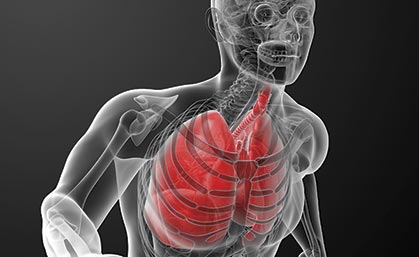The Forgotten Muscle

Strengthen your thoracic diaphragm to become a better runner
Photo by iStockphoto.
When trail runners strength train, they often incorporate squats, lunges, plyometrics and core work. While these exercises are worthwhile, don’t overlook an oft-neglected muscle that’s capable of improving balance, stability, efficiency and oxygen economy—the thoracic diaphragm.
The thoracic diaphragm, a sheet of muscle that extends across the bottom of the rib cage, is crucial for all types of athletic performance, especially endurance sports. The thoracic diaphragm separates your heart and lungs from your abdomen. When you inhale, the diaphragm contracts and depresses, pulling air into our lungs. As you exhale, the diaphragm relaxes and allows air to escape the lungs.
In terms of athletic performance, learning to use your diaphragm properly can correlate to increased stamina, quicker recovery and even decreased chance of injury.
Bad Breath
As newborns, we are all perfect little belly breathers. But, as we age, many of us become poor breathers due to bad posture and often-sedentary lifestyles. We rely on secondary respiration muscles like the tiny muscles between the ribs, as well as neck and upper-back muscles, in place of the true respiratory powerhouse, the thoracic diaphragm. This type of breathing leads to inefficient oxygenation of the blood, which results in fatiguing faster on the run.
Some researchers even theorize that ineffective breathing could be the cause of the “side stitch.” When the diaphragm is not used appropriately in the first few minutes of a run, researchers postulate, it may later spasm or cramp due to the sudden increased demand as the body becomes fatigued.
When you breathe using your diaphragm, it feels like pushing air toward your groin as your abdomen expands 270 degrees. When you do so, you build IAP, or intra-abdominal pressure. A 2013 International Journal of Sports Physical Therapy literature review suggests that IAP plays a crucial role in stabilizing the spine, particularly during dynamic and repetitive tasks. The same study also determined that proper IAP allows other core muscles like the abdominals, lower back and pelvic floor to perform at a higher level for a longer period of time—pure gold for endurance runners.
What’s It to a Runner?
For trail runners, two of the greatest benefits associated with proper breath control are improved balance and running efficiency.
As we learn to breathe from our diaphragm, we strengthen our core by removing some of the burden of stabilization from our larger prime movers, such as the abdomen and lower-back muscles. Proper breathing allows these muscles to stay supple and relaxed. This is crucial because when we catch a toe on a root, or need to leap over an obstacle in the trail, our prime movers can then help absorb the impact—a task they’re less capable of when fatigued from trying to stabilize a weak core.
When we use our diaphragm to breathe properly, it makes it easier for our blood to pull oxygen out of the air we inhale, which translates into improved running economy and endurance. Of course, as you become fatigued, it’s often necessary to rely on secondary muscles of respiration as well—but, ideally, the diaphragm should be the primary muscle used.
With all of this diaphragm talk, I’m sure you’re dying to know, “How do I become a breathing ninja?”
4 Drills to Improve Your Breathing
- Drill 1: Lie on your back with feet propped up on a chair, physio-ball or anything that keeps your thighs perpendicular to the floor and shins parallel to the floor. Keep your chin in a neutral to slightly tucked position. Place one hand on your chest and the other on your stomach. Now, try to draw your breath toward your groin, while allowing your abdomen to expand. The hand on your stomach should rise and fall with each breath, while the hand on your chest remains relatively still.
- Drill 2: Once you are able to breathe comfortably using your diaphragm as described in Drill 1, simply remove the foot support. Keep your lower back in contact with the floor. Take 10 to 12 breaths while keeping chin neutral and your legs at the 90-90 position.
- Drill 3: Lie on your back with your head about 10 inches away from a wall. Start in the same position as Drill 2, then move your arms overhead and press your palms into the wall, exerting force. Maintain good chin, low-back and leg position, and again, aim for 10 to 12 breaths.
- Drill 4: To incorporate diaphragmatic breathing into your running, start slowly and focus on breathing appropriately for at least your first few miles, before your body begins to fatigue. By warming up your diaphragm and setting the framework for proper breathing early, you can reprogram the way your brain, nervous system and musculature interact with one another—eventually helping you perform at a higher level for a longer period of time.
This article originally appeared in our September 2014 issue.